Individual Differences in Human Functioning
- Books Name
- Psychology Book Class-12
- Publication
- PathSet Publications
- Course
- CBSE Class 12
- Subject
- Psychology
Individual Differences in Human Functioning
- Each one of us is unique as we exemplify a typical combination of various traits i.e. different traits exist in an individual in varying degrees or intensities.
- Individual Differences refers to distinctiveness and variations among people's characteristics and behaviour patterns.
- Situationism states that situations and circumstances in which one is placed influence one's behaviour.
- Sometimes, the situational influences are so powerful that individuals with differing personality traits respond to them in almost the same ways. The situationist perspective views human behaviour relatively more as a result of influence of external factors
Assessment of Psychological Attributes
- Books Name
- Psychology Book Class-12
- Publication
- PathSet Publications
- Course
- CBSE Class 12
- Subject
- Psychology
Assessment of Psychological Attributes
- It is the first step in understanding a psychological attribute.
- It refers to the measurement of psychological attributes of individuals and their evaluation, often using multiple methods in terms of certain standards of comparison.
- Psychological assessment uses systematic testing procedures to evaluate abilities, behaviours, and personal qualities of individuals.
- There are two types of Assessment:
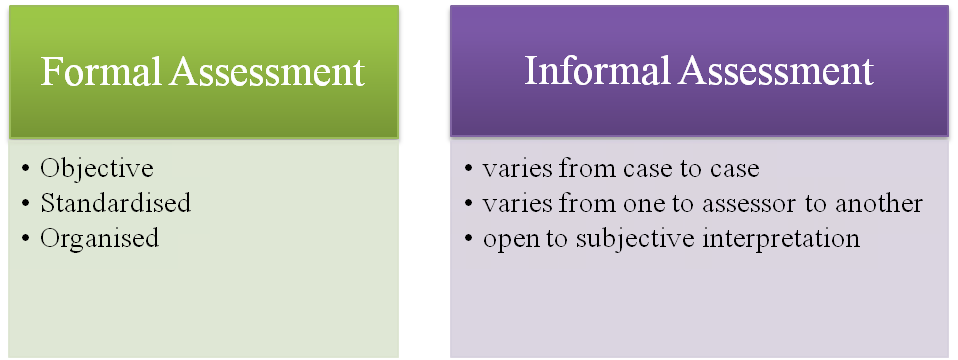
Characteristics of Psychological Attributes
- Complex in nature
- Multi-dimensional (Cognitive, Emotional, Social, etc.)
Psychological Attributes
Intelligence
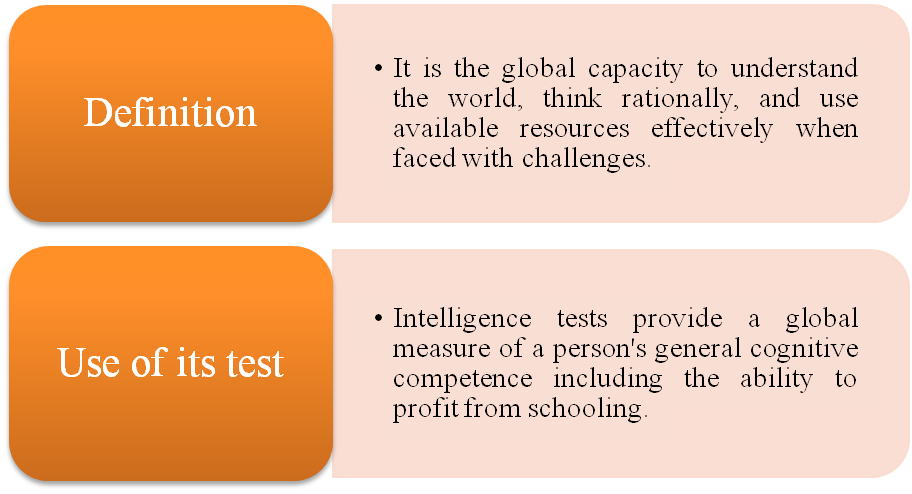
Aptitude
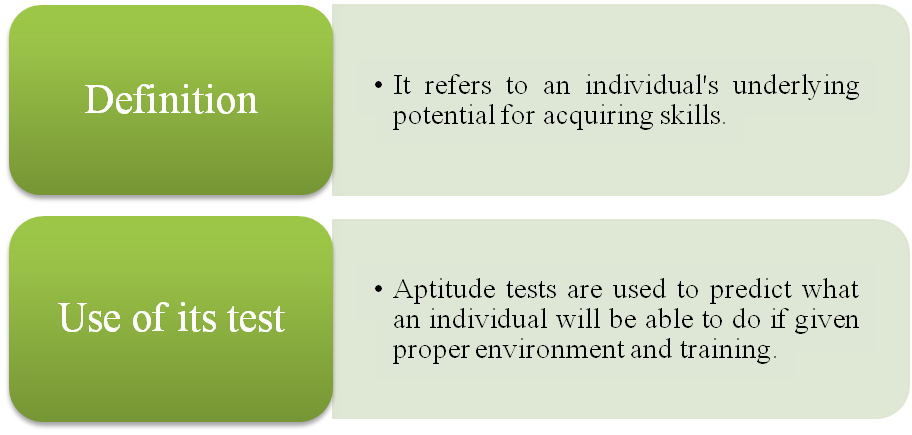
Interest
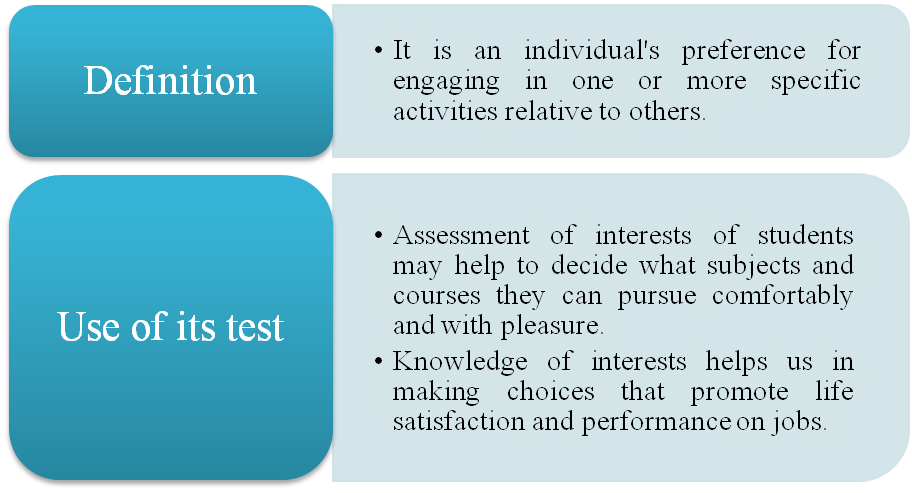
Personality
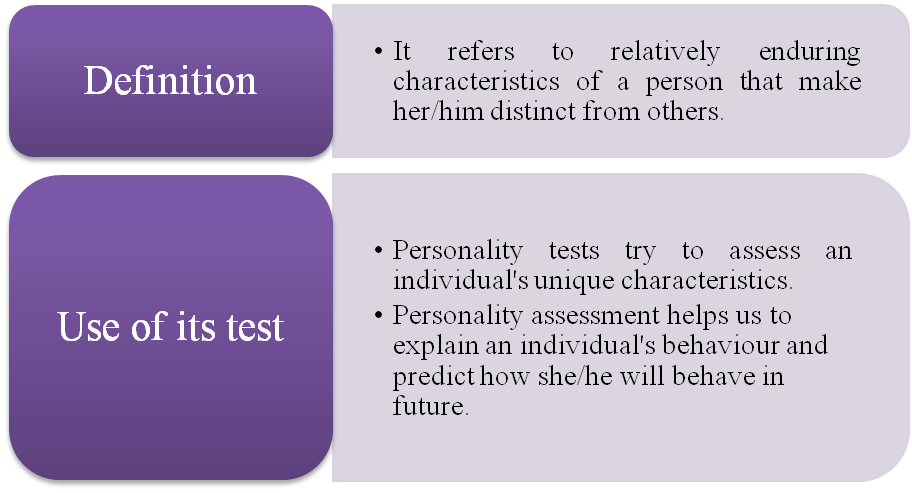
Values
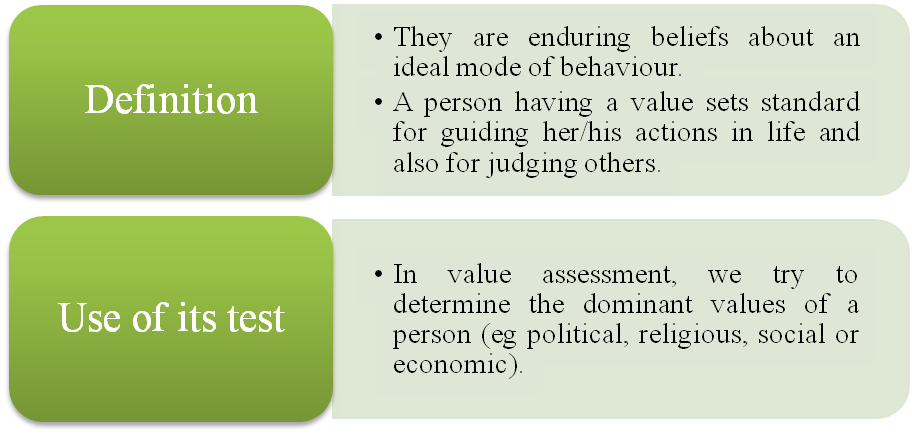
Assessment Methods
Psychological Test
- It is an objective and standardised measure of an individual's mental and/or behavioural characteristics.
- They are used for:
- Clinical diagnosis
- Guidance
- Personnel selection
- Placement
- Training
Interview
- It involves seeking information from a person on a one-to-one basis.
- It is used when:
- Counsellor interacts with a client -Salesperson makes a door-to-door survey
- Employer selects employees
Case Study
- It is an in-depth study of the individual in terms of her/his psychological attributes, psychological history in the context of her/his psychosocial and physical environment.
- It is used by clinical pcychologists.
Observation
- It involves employing systematic, organised, and objective procedures to record behavioural phenomena occuring naturally in real time.
Self Report
- It is a method in which a person provides factual information about herself / himself and/or opinions, beliefs, etc. that she/he holds.
- Such information may be obtained by using an interview schedule or a questionnaire, a psychological test or a personal diary.
Intelligence and Theories of Intelligence
- Books Name
- Psychology Book Class-12
- Publication
- PathSet Publications
- Course
- CBSE Class 12
- Subject
- Psychology
Definitions of Intelligence
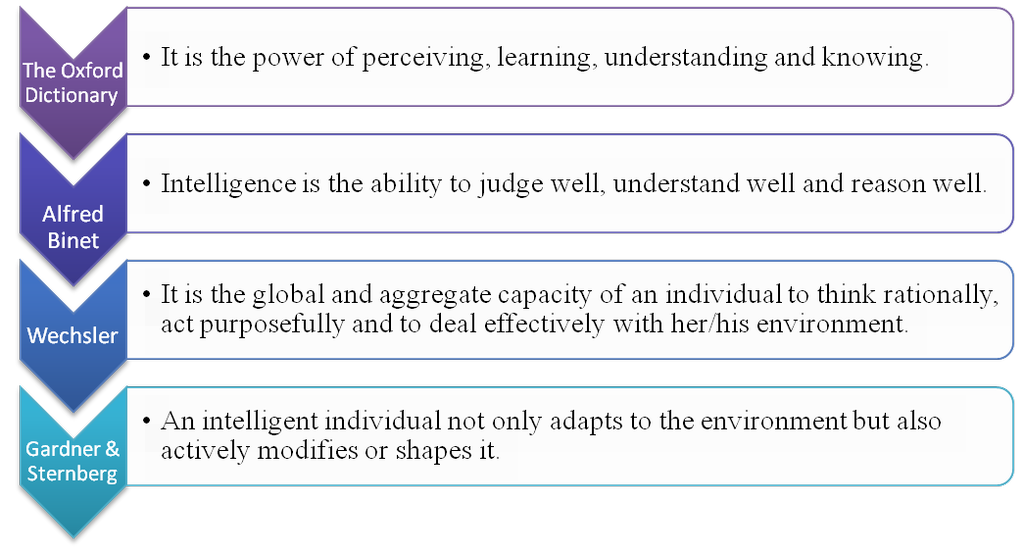
Theories of Intelligence
There are two approaches to theories of intelligence:
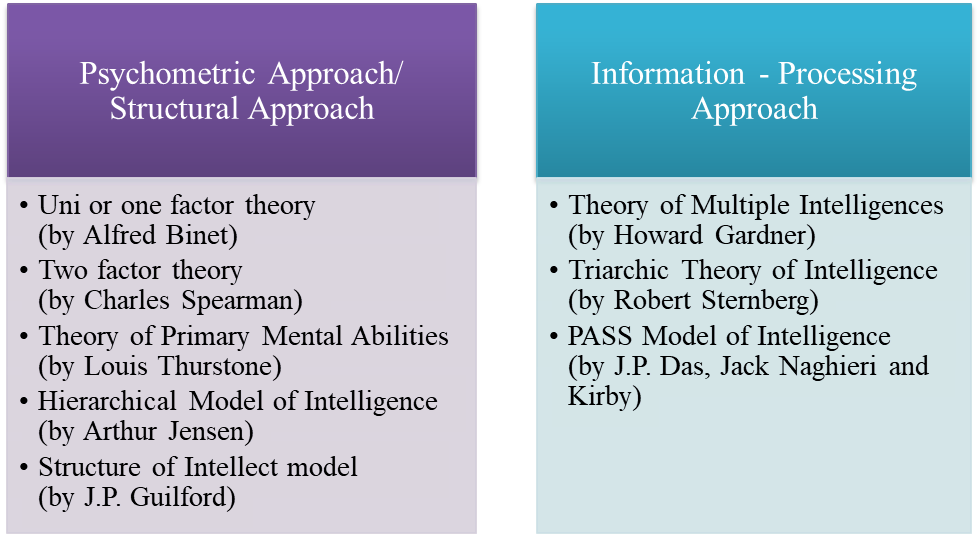
Psychometric approach/ Structural approach
- considers intelligence as an aggregate of abilities
- expresses the individual's performance in terms of a single index of cognitive abilities
A. Uni or one factor theory (by Alfred Binet)
According to him, intelligence consists of one similar set of abilities which can be used for solving any or every problem in an individual's environment.
B. Two factor theory (by Charles Spearman)
According to him, intelligence consists of:
i. General factor (g-factor) which includes mental operations which are primary and common to all performances.
ii. Specific factors (s-factors) which contains specific abilities which allow individuals to excel in their respective domains / fields. For eg, singing, dancing, cooking etc.
C. Theory of Primary Mental Abilities (by Louis Thurstone)
It states that intelligence consists of 7 primary abilities, independent of each other:
i. Verbal Comprehension - grasping meaning of words, concepts and ideas
ii. Numerical Abilities - speed and accuracy in numerical and computational skills
iii. Spacial Relations - visualising patterns and forms
iv. Perceptual speed - speed in perceiving details
v. Word Fluency - using words fluently and flexibly
vi. Memory - accuracy in recalling information
vii. Inductive Reasoning - deriving general rules from presented facts
D. Hierarchical Model of Intelligence (by Arthur Jensen)
This model consists of abilities operating at two levels:
i. Level I
It is the associative learning in which output is more or less similar to the input (for eg rote learning and memory)
ii. Level II
It is also called cognitive competence which involves higher order skills as they transform the input to produce an effective output.
E. Structure of Intellect model (J.P. Guilford)
It classifies intellectual traits among 3 dimensions:
i. Operations
- what the respondent does
- includes cognition, memory recording, memery retention, divergent production, convergent production, and evaluation
ii. Contents
- the nature of materials or information on which intellectual operations are performed.
- includes visual, auditory, symbolic (letters and numbers), semantic (words), behavioural (information about people's behaviour, attitudes, needs).
iii. Products
- the form in which information is processed by the respondent.
- classified into units, classes, relations, systems, transformations, and implications.
Information-Processing Approach
- describes the processes people use in intellectual reasoning and problem solving
- focuses on how an intelligent person acts
- emphasizes on studying cognitive functions underlying intelligent behaviour
A. Theory of Multiple Intelligences (by Howard Gardner)
According to him,
- intelligence is not a single entity
- distinct types of intelligence exist -independent of each other
- different types of intelligences interact and work together to find a solution to a problem
He described 8 types of intelligences:
i. Linguitic Intelligence
- skills involved in the production and use of language
- use language fluently and flexibly
- to express one's thinking and understand others
- 'word-smart' people who are sensitive to different shades of word meanings, articulate, and can create linguistic images in their mind.
- examples: poets and writers
ii. Logical-Mathematical Intelligence
- skills in scientific thinking and problem solving
- think logically and critically
- engage in abstract reasoning
- can manipulate symbols to solve mathematical problems
- examples: Scientists and Nobel Prize winners
iii. Spatial Intelligence
- skills in forming visual images and patterns -abilities involved in forming, using, and transforming mental images.
- can easily represent the spatial world in the mind
- examples: Pilots, Sailors, Sculptors, Painters, Architects, Interior decorators, Surgeons
iv. Musical Intelligence
- sensitivity to musical rhythms and patterns
- capacity to produce, create and manipulate musical patterns
- sensitive to sounds and vibrations
- sensitive to creating new patterns of sounds
- examples: Musicians, Sound Engineers, Singers, Instrumentalists
v. Bodily-Kinaesthetic Intelligence
- using whole or portions of the body flexibly and creatively for display or construction of products and problem solving
- examples: Athletes, dancers, actors, surgeons, gymnasts, sportspersons
vi. Intrapersonal Intelligence
- awareness of one's own feelings, motives and desires
- knowledge of one's internal strengths and limitations
- using that knowledge to effectively relate to others
- have finer sensibilities regarding their identity, human existence and meaning of life
- examples: Philosophers, Spiritual leaders
vii. Interpersonal Intelligence
- sensitivity to subtle aspects of others' behaviours
- skill of understanding the motives, feelings and behaviours of other people
- bond into a confortable relationship with others
- examples: counsellors, psychologists, politicians, social workers, religious leaders
viii. Naturalistic Intelligence
- sensitivity to the features of natural world -complete awareness of our relationship with the natural world
- recognising the beauty of different species of flora and fauna
- useful in making subtle discriminations in the natural world.
- examples: Hunters, farmers, tourists, botanists, zoologists, bird watchers
B. Triarchic Theory of Intelligence (by Robert Sternberg)
He views intelligence as the ability to adapt, to shape and select environment to accomplish one's goals and those of one's society and culture.
According to this theory, there are 3 types of intelligences:
i. Componential Intelligence / Analytical Intelligence
- The analysis of information to solve problems
- Think analytically and critically
- Succeed in schools
- This intelligence has three components:
a. Knowledge Acquisition - responsible for learning and acquisition of the ways of doing things.
b. Meta or Higher order - involves planning concerning what to do and how to do
c. Performance - involves actually doing things
ii. Experiential Intelligence / Creative Intelligence
- involved in using past experiences creatively to solve novel problems.
- reflected in creative performance.
- integration of different experiences in an original way to make new discoveries and inventions.
- quickly find out which information is crucial in given a situation.
iii. Contextual Intelligence / Practical Intelligence
- involves the ability to deal with environmental demands encountered on a daily basis.
- called 'street smartness' or 'business sense'
- easily adapt to their present environment or select a favourable environment than the existing one or modify the environment to fit their needs.
- successful in life
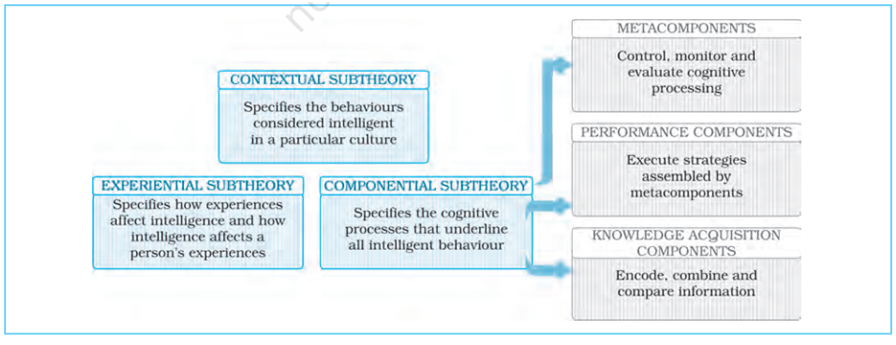
C. PASS Model of Intelligence (by J.P. Das, Jack Naghieri and Kirby)
According to this model, intellectual activity involves the interdependent functioning of three neurological systems, called the functional units of brain. These units are responsible for the following:
i. Arousal / Attention
- State of arousal is basic to any behaviour as it helps us in attending to stimuli.
- Arousal and attention enable a person to process information.
- An optimum level of arousal focuses our attention to the relevant aspects of a problem.
- Too much or too little arousal would interfere with attention.
ii. Simultaneous and Successive Processing
Information can be integrated into your knowledge system either:
a. Simultaneously
Simultaneous processing takes place when you perceive the relations among various concepts and integrate them into a meaningful pattern for comprehension. Example - Raven's Progressive Matrices Test - It helps us in grasping the meaning and relationship between the given abstract figures.
b. Successively
Successive processing takes place when we remember all the information serially so that the recall of one leads to the recall of another.
Example - Learning of digits, alphabets, multiplication tables
iii. Planning (essential feature of intelligence)
- Planning is activated, after the information is attended to and processed.
- allows us to think of the possible courses of action, implement them to reach a target, and evaluate their effectiveness.
These processes (Arousal/Attention, Simultaneous and Successive Processing and Planning) are interactive and dynamic.
Cognitive Assessment System (by Das and Naglieri)
- battery of tests
- consists of verbal as well as non-verbal tasks
- measure cognitive functions
- independent of schooling
- between 5 to 18 yrs of age
- results can be used to remedy cognitive deficits of children with learning problems.
Intelligence: Interplay of Nature and Nurture
- Books Name
- Psychology Book Class-12
- Publication
- PathSet Publications
- Course
- CBSE Class 12
- Subject
- Psychology
Intelligence: Interplay of Nature and Nurture/ Product of complex interaction of Nature and Nurture
Correlation of intelligence:
- Identical twins reared together - 0.90
- Identical twins reared in different environments - 0.72
- Fraternal twins reared together - 0.60
- Siblings reared together - 0.50
- Siblings reared apart - 0.25
- Children's intelligence is more similar to their biological rather than adoptive parents. However, as children grow in age, their intelligence level tends to move closer to that of their adoptive parents.
- Environmental deprivation lowers intelligence while rich nutrition, good family background and quality of schooling increases intelligence.
- Heredity is something that sets a range within which an individual's development is actually shaped by the support and opportunities of the environment.
Assessment of Intelligence
- Books Name
- Psychology Book Class-12
- Publication
- PathSet Publications
- Course
- CBSE Class 12
- Subject
- Psychology
Assessment of Intelligence
- 1905 - Alfred Binet and Theodore Simon - first attempt to formally measure intelligence (Binet-Simon Scale)
- Mental Age (MA) is a measure of a person's intellectual development relative to people of her/his age group.
- Chronological Age (CA) is the biological age from birth.
- Retardation was defined as being two mental age years below the chronological age.
- IQ = MA/CA x 100 (by William Stern in 1912)
Intelligence Quotient (IQ) refers to mental age divided by chronological age multiplied by 100. The number 100 is used as a multiplier to avoid the decimal point.
MA = CA, IQ = 100
MA > CA, IQ > 100
MA < CA, IQ < 100
- For example, a 10-year-old child with a mental age of 12 would have an IQ of 120 (12/10 x 100), whereas the same child with an MA of 7 would have an IQ of 70 (7/10 x 100).
- The scores of most people tend to fall in the middle range of the distribution. Only a few people have either very high or very low scores.
- The frequency distribution for the IQ scores tends to approximate a bell-shaped curve, called the normal curve. This type of distribution is symmetrical around the central value, called the mean.
- Mean IQ score in a population is 100.
- People with IQ scores in the range of 90–110 have normal intelligence.
- Those with IQ below 70 are suspected to have ‘intellectual disability’, while persons with IQ above 130 are considered to have exceptional talents.
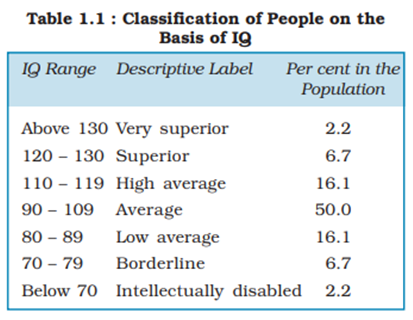
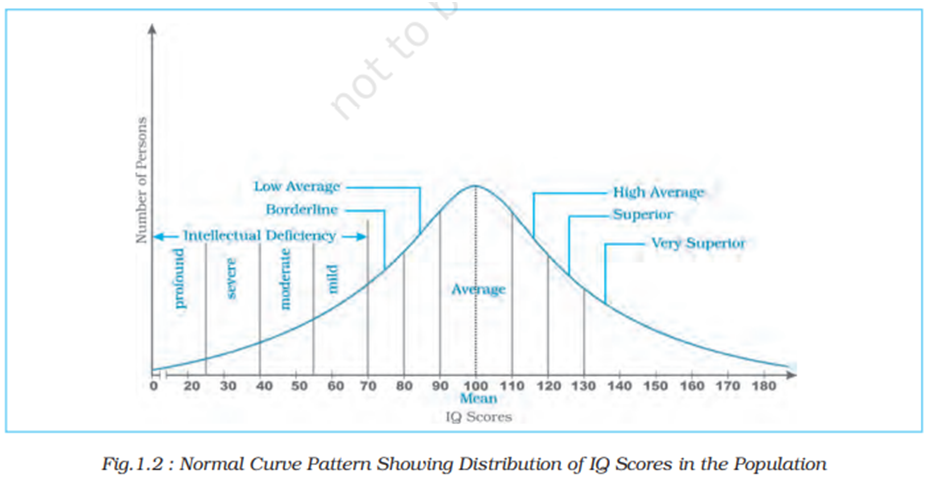
Variations of Intelligence
- Books Name
- Psychology Book Class-12
- Publication
- PathSet Publications
- Course
- CBSE Class 12
- Subject
- Psychology
Variations of Intelligence
Intellectual Deficiency
- Children face enormous difficulty in learning even very simple skills
- These children who show intellectual deficiency are 'intellectually disabled'
- The American Association on Mental Deficiency (AAMD) views intellectual disability as "significantly sub-average general intellectual functioning existing concurrently with deficits in adaptive behaviour and manifested during the developmental age."
Three features of the above definition are:
- 'significantly sub-average intellectual functioning' is a must to be regarded as intellectually disabled having IQ below 70.
- 'deficits in adaptive behaviour' where, adaptive behaviour means a person's capacity to be independent and deal effectively with one's environment.
- deficits must be observed during the 'developmental period' i.e. between 0 and 18yrs of age.
- Taught to work and function with special attention
- Some cannot be trained and require institutional care throughout their lives
- Different levels of intellectually disability:
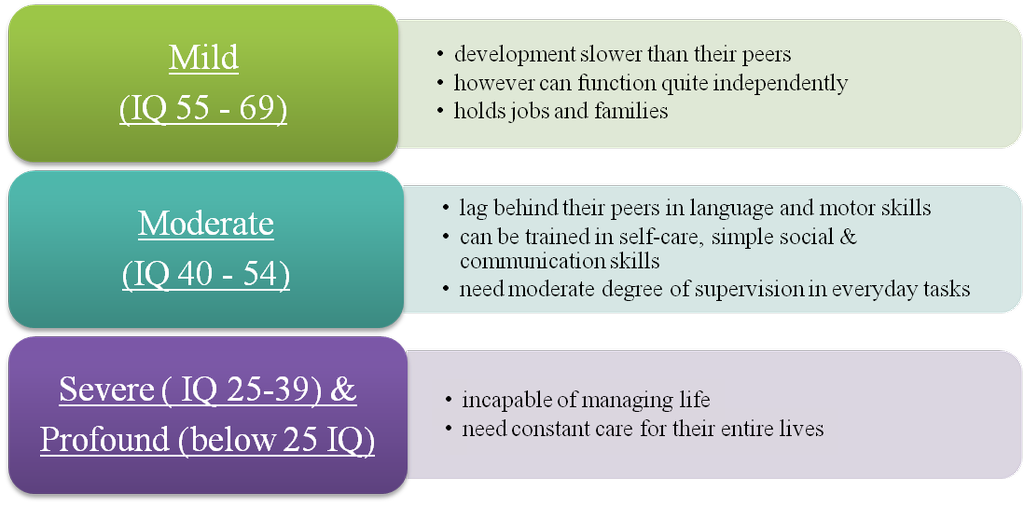
Intellectual Giftedness
- Higher performance because of their outstanding potentialities.
- Giftedness is exceptional general ability shown in superior performance in a wide variety of areas
- Talent refers to remarkable ability in a specific field. The highly talented are sometimes called 'prodigies'.
- Giftedness depends on a combination of high ability, high creativity, and high commitment, from teachers’ point of view.
- Gifted children show early signs of intellectual superiority. Even during infancy and early childhood, they show:
- larger attention span
- good recognition memory
- preference for novelty
- sensitivity to environmental changes
- early appearance of language skills
Characteristics of gifted children are:
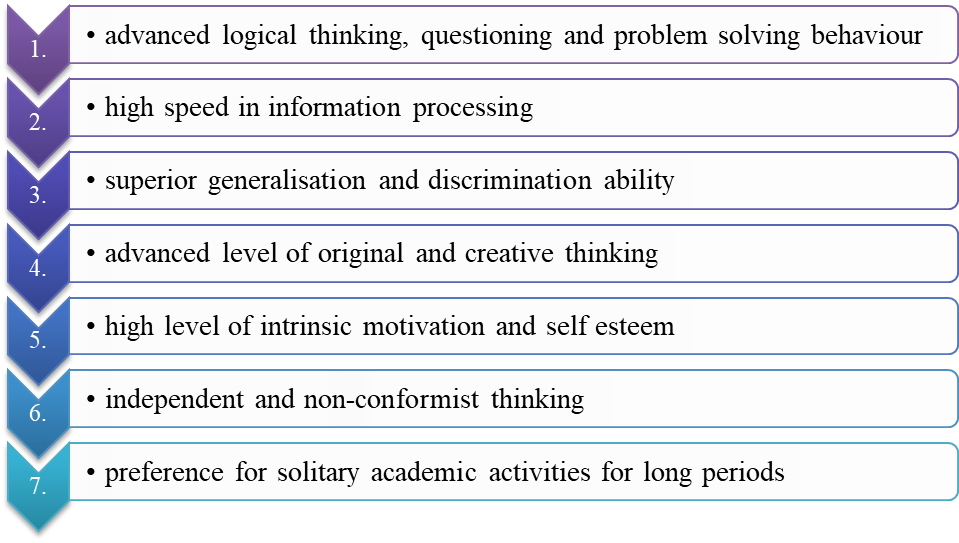
Types of Intelligence Tests
- Books Name
- Psychology Book Class-12
- Publication
- PathSet Publications
- Course
- CBSE Class 12
- Subject
- Psychology
Types of Intelligence Tests
Individual or Group Tests
- Individual Tests
- Individual tests are administered to one person at a time.
- These tests require the test administrator to establish a rapport with the subject and be sensitive to her/his feelings, moods expressions during the testing session.
- These allow people to answer orally in a written form or manipulate objects as per the tester's instructions.
Group Tests
- A group intelligence test can be administered to several persons simultaneously.
- These do not allow an opportunity to be familiar with the subjects' feelings.
- They seek written answers usually in a MCQ format.
Verbal, Non-verbal or Performance Tests
Verbal Tests
- These tests require subjects to give verbal responses either orally or in written form.
- These tests can be administered only to literate people.
Non-Verbal Tests
- The non-verbal tests use pictures or illustrations as test items. These can be administered on illiterate people as well.
- Example- Raven's Progressive Matrices (RPM) Test
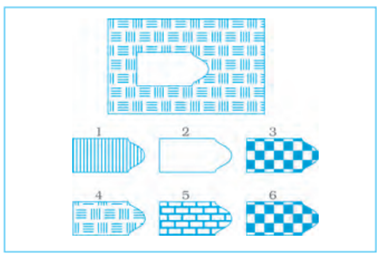
Performance Tests
- Performance tests require subjects to manipulate objects and other materials to perform a task.
- Written language is not necessary for answering the items.
- They can be easily administered to people from different cultures.
- Example- Kohs' Block Design Test
Culture-Fair or Culture-Biased Tests
Culture-Fair Tests
- Culture-fair or culturally appropriate tests are those that do not discriminate against individuals belonging to different cultures.
- These tests are developed in a manner that they assess experiences common to all cultures or have questions in which language usage is not required.
- Non-verbal and performance tests help reduce the cultural bias usually associated with verbal tests.
Culture-Biased Tests
- Culture-biased tests are designed for a specific population and show biased results for a specific group, culture, and population due to cultural influence.
Misuses of Intelligence Tests
- Poor performance on a test may make the child ashamed and thereby adversely affect their performance and self-respect.
- The results of the test may invite discriminatory practices / treatment from parents, teachers and elders in the society.
- Intelligence tests do not capture creative potentialities and practical side of intelligence.
- They do not relate much to success in life.
- Administering a test biased in favour of high class and middle class populations may underestimate the IQ of children coming from disadvantaged sections of the society.
Intelligence Testing in India
- Books Name
- Psychology Book Class-12
- Publication
- PathSet Publications
- Course
- CBSE Class 12
- Subject
- Psychology
Intelligence Testing in India
- S.M. Mohsin made a pioneering attempt in constructing an intelligence test in Hindi in the 1930s.
- C.H. Rice attempted to standardise Binet’s test in Urdu and Punjabi.
- At about the same time, Mahalanobis attempted to standardise Binet’s test in Bengali.
- Attempts were also made by Indian researchers to develop Indian norms for some western tests including RPM, WAIS, Alexander’s Passalong, Cube Construction, and Kohs’ Block Design.
- Long and Mehta prepared a Mental Measurement Handbook listing out 103 tests of intelligence in India that were available in various languages.
- Since then, a number of tests have either been developed or adapted from western cultures.
- The National Library of Educational and Psychological Tests (NLEPT) at the National Council of Educational Research and Training (NCERT) has documented Indian tests. Critical reviews of Indian tests are published in the form of handbooks. NLEPT has brought out the handbooks in the area of intelligence, aptitude, personality, attitudes, and interests.
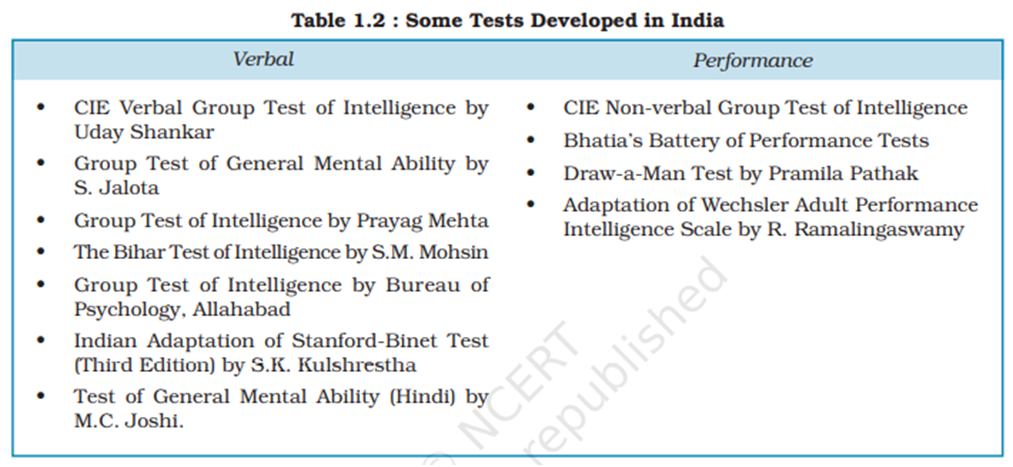
Culture and Intelligence
- Books Name
- Psychology Book Class-12
- Publication
- PathSet Publications
- Course
- CBSE Class 12
- Subject
- Psychology
Culture and Intelligence
- Culture is a collective system of customs, beliefs, attitudes and achievements in art and literature.
- The cultural environment provides a context for intelligence to develop.
- Vygotsky, a Russian psychologist, has argued that culture provides a social context in which people live, grow and understand the world around them.
For example, in less technologically developed societies, social and emotional skills in relating to people are valued, while in technologically advanced societies, personal achievement founded on abilities of reasoning and judgment is considered to represent intelligence.
- Vygotsky also believed that cultures, like individuals, have a life of their own; they grow and change, and in the process specify what will be the end-product of successful intellectual development.
- According to him, while elementary mental functions (e.g., crying, attending to mother’s voice, sensitivity to smells, walking, and running) are universal, the manner in which higher mental functions such as problem solving and thinking operate are largely culture-produced.
- Sternberg's notion of contextual or practical intelligence implies that intelligence is a product of culture.
Technological Intelligence
- In technologically advanced societies, personal achievement founded on abilities of reasoning and judgement is considered to represent intelligence.
- Focus on individualistic orientation.
- Technologically advanced societies adopt child rearing practices that foster skills of:
- Generalisation and abstraction
- Speed
- Minimal moves
- Mental manipulation, among children.
- In these societies, people are well-versed in skills of:
- Attention
- Observation
- Analysis
- Performance
- Speed
- Achievement orientation
Intelligence tests developed in western cultures look precisely for these skills in an individual.
Intelligence in the Indian Tradition
- Books Name
- Psychology Book Class-12
- Publication
- PathSet Publications
- Course
- CBSE Class 12
- Subject
- Psychology
Integral Intelligence (Intelligence in the Indian tradition)
- Gives emphasis on connectivity with the social and world environment.
- From a holistic perspective, equal attention is paid to cognitive and non cognitive processes as well as their integration as a part of intelligence.
- Focus on collectivistic orientation
- Value self-reflection
- Less technologically developed societies value social and emotional skills in relating to people
- Buddhi, according to J.P. Das includes such skills as:
- Mental effort
- Determined action
- Feelings
- Opinions,
along with cognitive competence such as:
- Knowledge
- Discrimination
- Understanding
Buddhi is the knowledge of one's own self based on conscience, will and desire.
Buddhi has affective and motivational components besides a strong cognitive component.
- Facets of Intelligence in the Indian tradition :
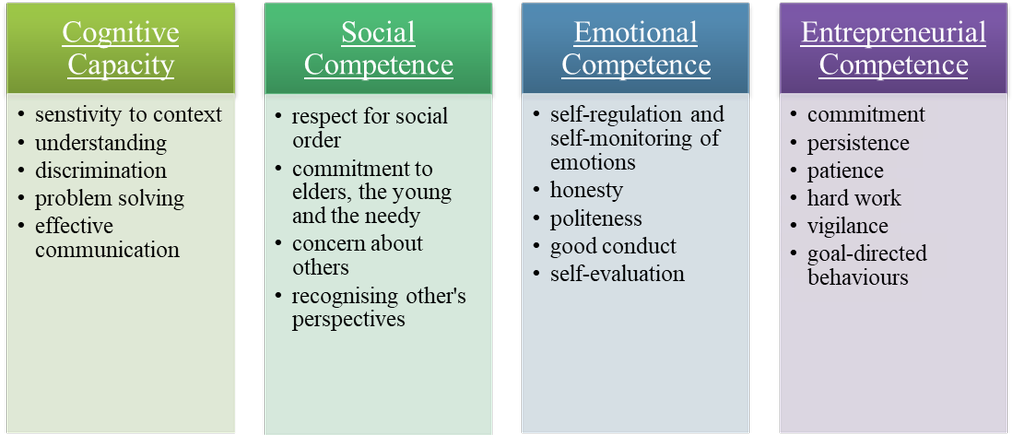
Emotional Intelligence
- Books Name
- Psychology Book Class-12
- Publication
- PathSet Publications
- Course
- CBSE Class 12
- Subject
- Psychology
Emotional Intelligence
- Considers that intelligence includes emotions.
- Emotional intelligence is a set of skills that underlie accurate appraisal, expression, and regulation of emotions.
- It is the feeling side of intelligence.
- Salovey and Mayer defined emotional intelligence as " the ability to monitor one's own and other's emotions, to discriminate among them, and to use the information to guide one's thinking and actions."
- Emotional Quotient (EQ) is used to express emotional intelligence in the same way as IQ is used to express intelligence.
- Emotional intelligence refers to the ability to process emotional information accurately and efficiently.
- Applications of Emotional Intelligence:
- Emotional intelligence is receiving increasing attention of educators for dealing with students who are affected by stresses and challenges of the outside world.
- Programmes aimed at improving students’ emotional intelligence have beneficial effects on their academic achievement.
- They encourage cooperative behaviour and reduce their antisocial activities.
- These programmes are very useful in preparing students to face the challenges of life outside the classroom.
Characteristics of Emotionally Intelligent People are:
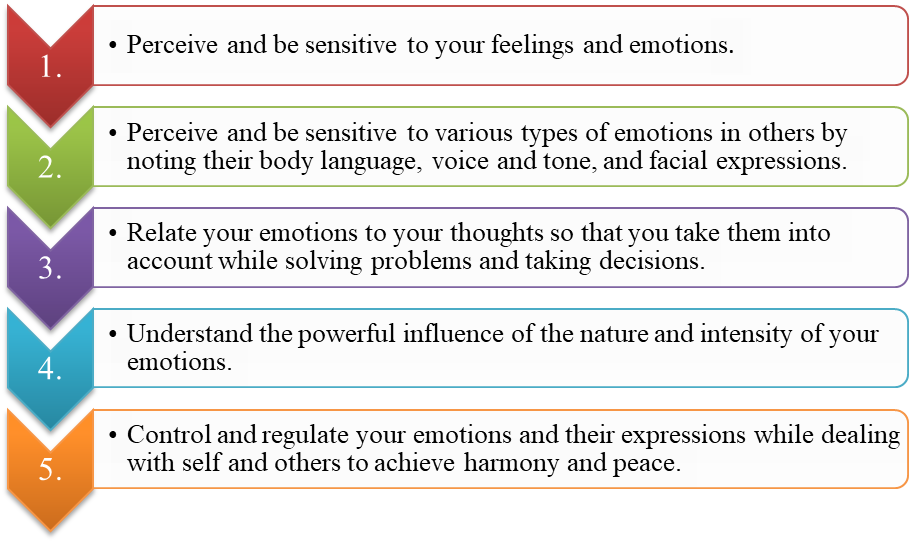
Aptitude : Nature and Measurement
- Books Name
- Psychology Book Class-12
- Publication
- PathSet Publications
- Course
- CBSE Class 12
- Subject
- Psychology
Aptitude and Intelligence
- People with similar intelligence differed widely in acquiring certain knowledge or skills.
- Therefore, individuals with similar level of intelligence may have different aptitudes. For example, two students who have more or less the same level of intelligence, one may have a high verbal reasoning aptitude whereas the other student may have high numerical reasoning aptitude and low verbal reasoning aptitude.
Aptitude and Interest
- A person may be interested in a particular job or activity, but may not have the aptitude for it. Similarly, a person may have the potentiality for performing a job, but may not be interested in doing that. In both cases, the outcome will not be satisfactory.
- For example, a student with high mechanical aptitude and strong interest in engineering is more likely to be a successful mechanical engineer.
- Therefore, in order to be successful in a particular field, a person must have both aptitude and interest.
Aptitude tests are available in two forms:
- Independent (specialised) Aptitude Tests
Examples: Clerical Aptitude, Mechanical Aptitude, Numerical Aptitude, and Typing Aptitude
- Multiple (generalised) Aptitude Tests
Multiple Aptitude Tests exist in the form of test batteries, which measure aptitude in several separate but homogeneous areas.
Examples: Differential Aptitude Tests (DAT), the General Aptitude Tests Battery (GATB), and the Armed Services Vocational Aptitude Battery (ASVAB) are well-known aptitude test batteries.
Among these, DAT is most commonly used in educational settings. It consists of 8 independent subtests: (i) Verbal Reasoning, (ii) Numerical Reasoning, (iii) Abstract Reasoning, (iv) Clerical Speed and Accuracy, (v) Mechanical Reasoning, (vi) Space Relations, (vii) Spelling, and (viii) Language Usage.
J.M. Ojha has developed an Indian adaptation of DAT.
Several other aptitude tests have been developed in India for measuring scientific, scholastic, literary, clerical, and teaching aptitudes.
Creativity and Intelligence
- Books Name
- Psychology Book Class-12
- Publication
- PathSet Publications
- Course
- CBSE Class 12
- Subject
- Psychology
Creativity
- Creativity is the ability to produce ideas, objects, or problem solutions that are novel, appropriate and useful.
- Manifestations of creativity can be observed in:
- a novel solution to a problem
- an invention
- composition of a poem or a painting
- new chemical process
- an innovation in law
- a breakthrough in preventing a disease, etc
- One common element among these is the production of something new and unique.
- Creativity is not just limited to a selected few — the artist, the scientist, the poet or the inventor. An ordinary individual who is engaged in simple occupations like pottery, carpentry, cooking, etc. can also be creative.
- Individuals vary in terms of the level and the areas in which they exhibit creativity and that all may not be operating at the same level.
- Another level of creativity is working on what has already been established earlier by way of modifications, by putting things in new perspectives or to new use.
- Children express creativity mostly through physical activities and in non-verbal ways.
- Creativity is determined by both heredity and environment. Limits of the creative potential are set by heredity, and environmental factors (such as motivation, commitment, family support, peer influences, training opportunities, etc.) stimulate the development of creativity.
Creativity and Intelligence
- Terman, in the 1920s, found that:
- persons with high IQ were not necessarily creative
- creative ideas could come from persons who did not have a very high IQ
- Both high and low level of creativity can be found in highly intelligent children and also children of average intelligence.
- The same person, thus, can be creative as well as intelligent but it is not necessary that intelligent ones, in the conventional sense, must be creative.
Intelligence, therefore, by itself does not ensure creativity.
- However, it has been found that the relationship between creativity and intelligence is positive.
- All creative acts require some minimum ability to acquire knowledge and capacity to comprehend, retain, and retrieve.
- Hence, a certain level of intelligence is required for creativity but beyond that intelligence does not correlate well with creativity.
Features of Creativity Tests
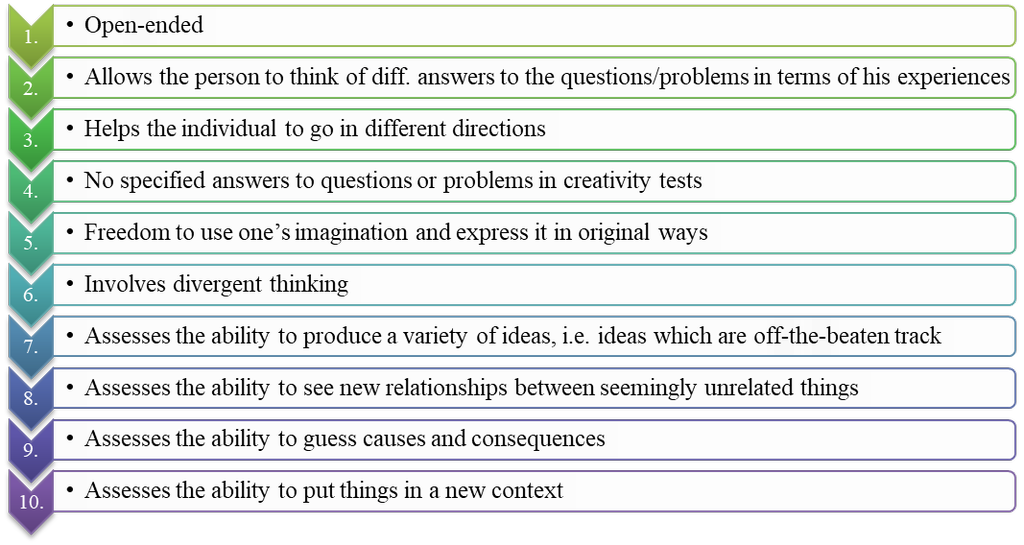
Some of the famous psychologists who have developed creativity tests are:
- Guilford
- Torrance
- Khatena
- Wallach and Kogan
- Paramesh
Features of Intelligence Tests
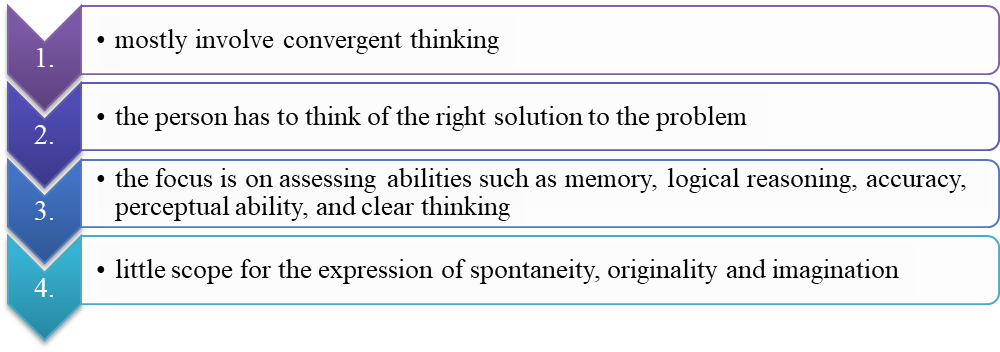
Concept of Self
- Books Name
- Psychology Book Class-12
- Publication
- PathSet Publications
- Course
- CBSE Class 12
- Subject
- Psychology
Self and Personality
Concept of Self :-
The Idea of Self
- A newly born child has no idea of its self. As a child grows older, the idea of self emerges and its formation begins.
- Parents, friends, teachers and other significant persons play a vital role in shaping a child’s ideas about self.
- Our interaction with other people, our experiences, and the meaning we give to them, serve as the basis of our self.
Personal Identity
- It refers to those attributes of a person that make her/him different from others.
- When a person describes herself/himself by telling her/his:
- Name (I am Shweta)
- Qualities or characteristics (I am honest and kind)
- Potentialities or capabilities (I am a singer)
- Beliefs (I believe in destiny)
Social Identity
- Social identity refers to those aspects of a person that link her/him to a social or cultural group or are derived from it. For example, I am a Hindu.
Self
- Self refers to the totality of an individual’s conscious experiences, ideas, thoughts and feelings with regard to herself or himself.
- These experiences and ideas define the existence of an individual both at the personal and at social levels.
Self as Subject and Self as Object
- An individual describes himself/herself either as:
- an entity that does something (e.g., I am a baker). In this case, the self is described as a ‘subject’ (who does something), or as;
- an entity on which something is done (e.g., I am one who easily gets hurt). In this case, the self is described as an ‘object’ (which gets affected).
Kinds of Self
- There are several kinds of self. They get formed as a result of our interactions with our physical and socio-cultural environments.
- There are two kinds of ‘self’:
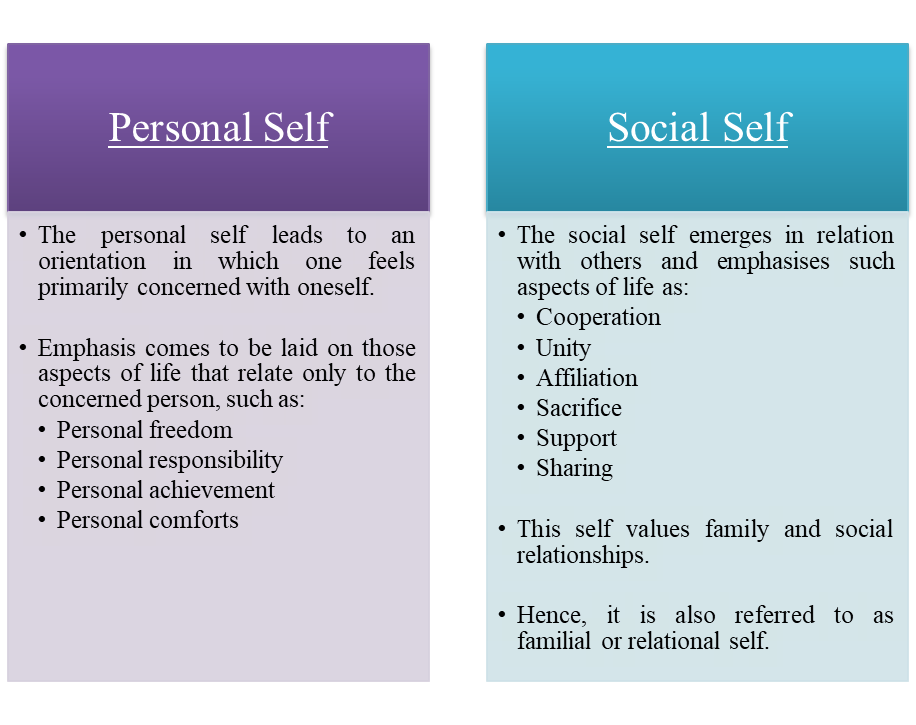
Cognitive and Behavioural Aspects of Self
- Books Name
- Psychology Book Class-12
- Publication
- PathSet Publications
- Course
- CBSE Class 12
- Subject
- Psychology
Cognitive and Behavioural Aspects of Self
- The way we perceive ourselves and the ideas we hold about our competencies and attributes is also called self-concept.
- At a very general level, this view of oneself is, overall, either positive or negative.
- The most frequently used method for finding out an individual’s self-concept involves asking the person about herself/ himself.
Self-esteem
- The value judgment of a person about herself/himself is called self-esteem.
- Studies indicate that by the age of 6 to 7 years, children seem to have formed self-esteem at least in four areas (mentioned below) which become more refined with age.
- academic competence
- social competence
- physical/ athletic competence
- physical appearance,
- Our capacity to view ourselves in terms of stable dispositions permits us to combine separate self-evaluations into a general psychological image of ourselves. This is known as an overall sense of selfesteem.
- Self-esteem shows a strong relationship with our everyday behaviour. For instance, children with high academic self-esteem perform better in schools than those with low academic self-esteem, and children with high social self-esteem are more liked by their peers than those with low social self-esteem.
- Children with low self-esteem are often found to display anxiety, depression, and increasing antisocial behaviour.
- Children with high self-esteem are often found to display confidence, is self-dependent and a social person.
- Warm and positive parenting helps in the development of high self-esteem among children as it allows them to know that they are accepted as competent and worthwhile.
- Children, whose parents help or make decisions for them even when they do not need assistance, often suffer from low self-esteem.
Self-efficacy
- People differ in the extent to which they believe they themselves control their life outcomes or the outcomes are controlled by luck or fate or other situational factors, e.g. passing an examination.
- A person who believes that s/he has the ability or behaviours required by a particular situation demonstrates high self-efficacy.
- The notion of self-efficacy is based on Bandura’s social learning theory. Bandura’s initial studies showed that children and adults learned behaviour by observing and imitating others.
- People’s expectations of mastery or achievement and their convictions about their own effectiveness also determine the types of behaviour in which they would engage, as also the amount of risk they would undertake.
- A strong sense of self-efficacy allows people to:
- select,
- influence,
- construct,
the circumstances of their own life,
- and feel less fearful.
- Our society, our parents and our own positive experiences can help in the development of a strong sense of selfefficacy by presenting positive models during the formative years of children.
Self-regulation
- Self-regulation refers to our ability to organise and monitor our own behaviour.
- People, who are able to change their behaviour according to the demands of the external environment, are high on self-monitoring.
- Many situations of life require resistance to situational pressures and control over ourselves. This becomes possible through ‘will power’.
- Learning to delay or defer the gratification of needs is called self-control. Self-control plays a key role in the fulfilment of long-term goals.
- Psychological techniques of self-control are:
a) Observation of own behaviour
This provides us with necessary information that may be used to change, modify, or strengthen certain aspects of self.
b)Self-instruction
We often instruct ourselves to do something and behave the way we want to. Such instructions are quite effective in self-regulation.
c) Self-reinforcement
This involves rewarding behaviours that have pleasant outcomes.
Culture and Self
- Books Name
- Psychology Book Class-12
- Publication
- PathSet Publications
- Course
- CBSE Class 12
- Subject
- Psychology
Culture and Self
Several aspects of self seem to be linked to the characteristic features of the culture in which an individual lives.
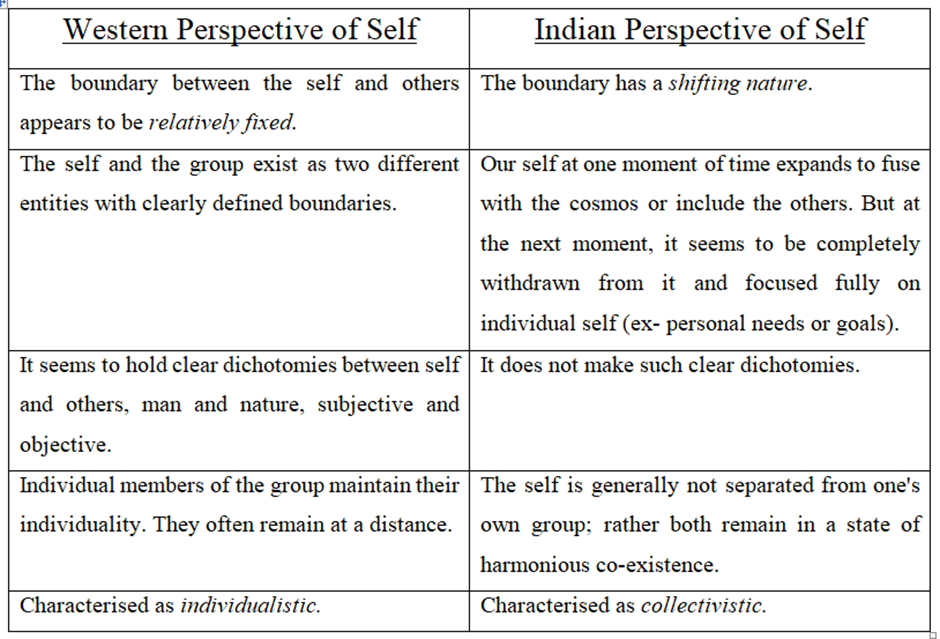

Concept of Personality
- Books Name
- Psychology Book Class-12
- Publication
- PathSet Publications
- Course
- CBSE Class 12
- Subject
- Psychology
Concept of Personality
- The literal meaning of personality is derived from the Latin word persona, the mask used by actors in the Roman theatre for changing their facial make-up.
- Personality refers to our characteristic ways of responding to individuals and situations.
- Personality refers to unique and relatively stable qualities that characterise an individual’s behaviour across different situations over a period of time.
- Consistency in behaviour, thought and emotion of an individual across situations and across time periods characterises her/his personality.
- However, situational variations in behaviour do occur as they help individuals in adapting to their environmental circumstances.
- Once we are able to characterise someone’s personality, we can predict how that person will probably behave in a variety of circumstances.
- An understanding of personality allows us to deal with people in realistic and acceptable ways.
Characteristics of Personality
- It has both physical and psychological components.
- Its expression in terms of behaviour is fairly unique in a given individual.
- Its main features do not easily change with time.
- It is dynamic in the sense that some of its features may change due to internal or external situational demands. Thus, personality is adaptive to situations.
Major Approaches to the Study of Personality
- Books Name
- Psychology Book Class-12
- Publication
- PathSet Publications
- Course
- CBSE Class 12
- Subject
- Psychology
Major Approaches to the Study of Personality

Type Approach
- The type approaches attempts to comprehend human personality by examining certain broad patterns in the observed behavioural characteristics of individuals.
- Each behavioural pattern refers to one type in which individuals are placed in terms of the similarity of their behavioural characteristics with that pattern.
- Personality types are used to represent and communicate a set of expected behaviours based on similarities.
1) Typology of Personality based on fluid or humour by Hippocrates
- He classified people into four types:
- Sanguine
- Phlegmatic
- Melancholic
- Choleric
- Each characterised by specific behavioural features.
2) Charak Samhita (famous treatise on Ayurveda)
- On the basis of three humoural elements called tridosha, it classifies people into the categories of:
- Vata
- Pitta
- Kapha
- Each refers to a type of temperament, called prakriti (basic nature) of a person.
Typology of Personality based on the Trigunas
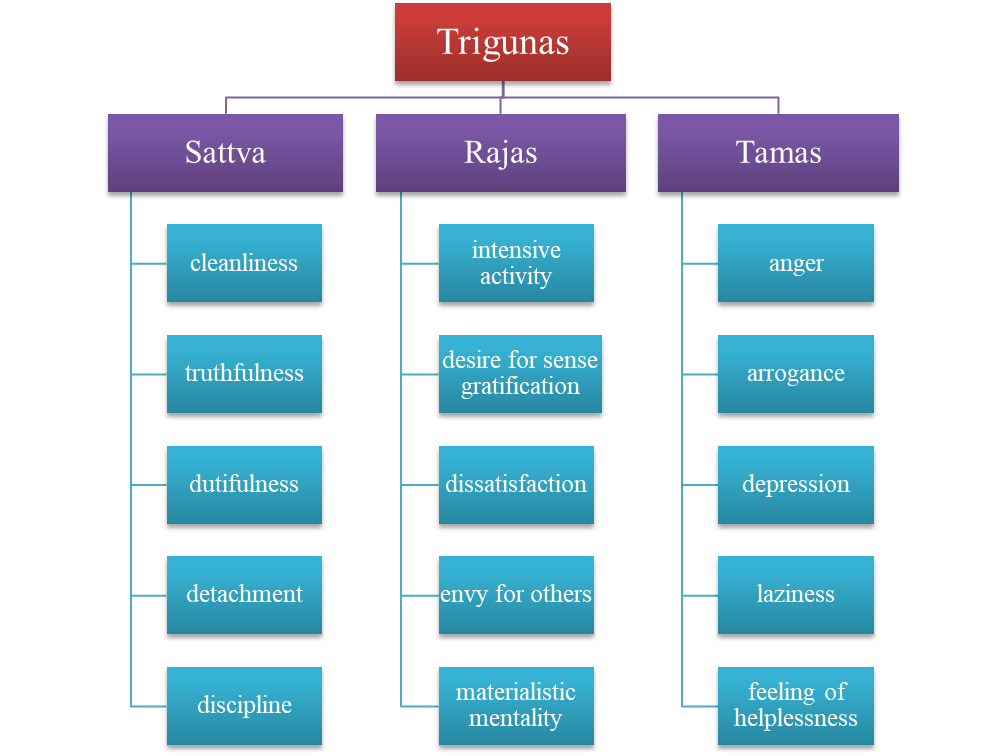
All the three gunas are present in each and every person in different degrees.
- The dominance of one or the other guna may lead to a particular type of behaviour.
- Typology by grouping people into Introverts and Extraverts by Jung

- Typology using Body Build and Temperament by Sheldon
- Typology – Type A, Type B, Type C and Type D
- Friedman and Rosenman classified individuals into Type A and Type B.
- This typology was further extended by Morris who suggested Type C personality.
- More recently, a Type D personality has been suggested.
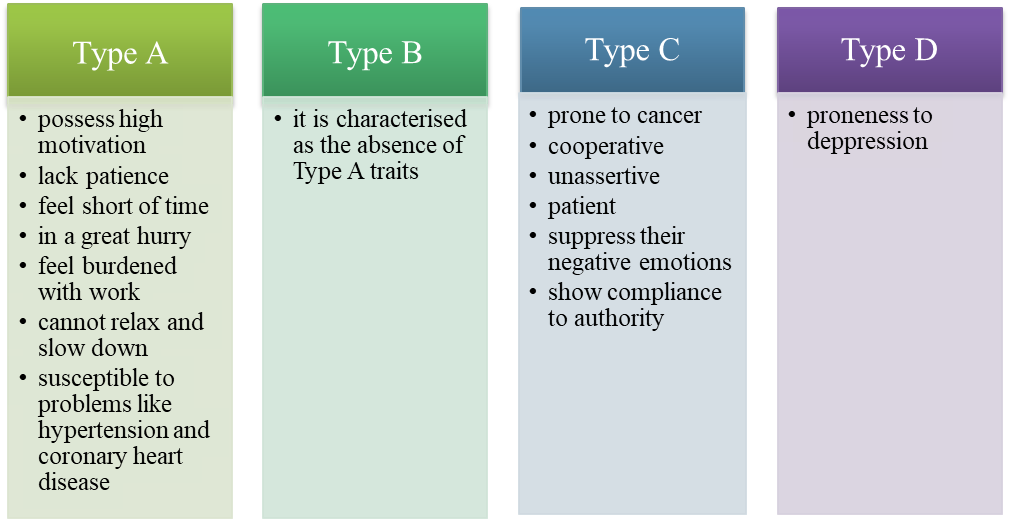
Trait Approach
- The trait approach focuses on the specific psychological attributes along which individuals tend to differ in consistent and stable ways.
- An approach to personality that seeks to identify the basic traits necessary to describe personality.
- It tries to discover the ‘building blocks’ of personality.
- It attempts to identify primary characteristics of people.
- Traits are:
- relatively stable over time
- generally consistent across situations
- their strengths and combinations vary across individuals leading to individual differences in personality
1) Cattell: Personality Factors
- Raymond Cattell believed that there is a common structure on which people differ from each other.
- This structure could be determined empirically.
- He tried to identify the primary traits from a huge array of descriptive adjectives found in language.
- He applied a statistical technique, called factor analysis, to discover the common structures.
- He found 16 primary or source traits which are stable, and are considered as the building blocks of personality. Cattell described the source traits in terms of opposing tendencies.
- There are also a number of surface traits that result out of the interaction of source traits.
- He developed a test, called Sixteen Personality Factor Questionnaire (16PF), for the assessment of personality which is widely used by psychologists.
2) Allport’s Trait Theory
- Gordon Allport is considered the pioneer of trait approach.
- He proposed that individuals possess a number of traits that:
- are dynamic in nature
- determine behaviour in such a manner that an individual approaches different situations with similar plans
- integrate stimuli and responses which otherwise look dissimilar
- Allport argued that the words people use to describe themselves and others provide a basis for understanding human personality. Therefore, he analysed the words of English language to look for traits which describe a person.
- Allport categorised traits into:
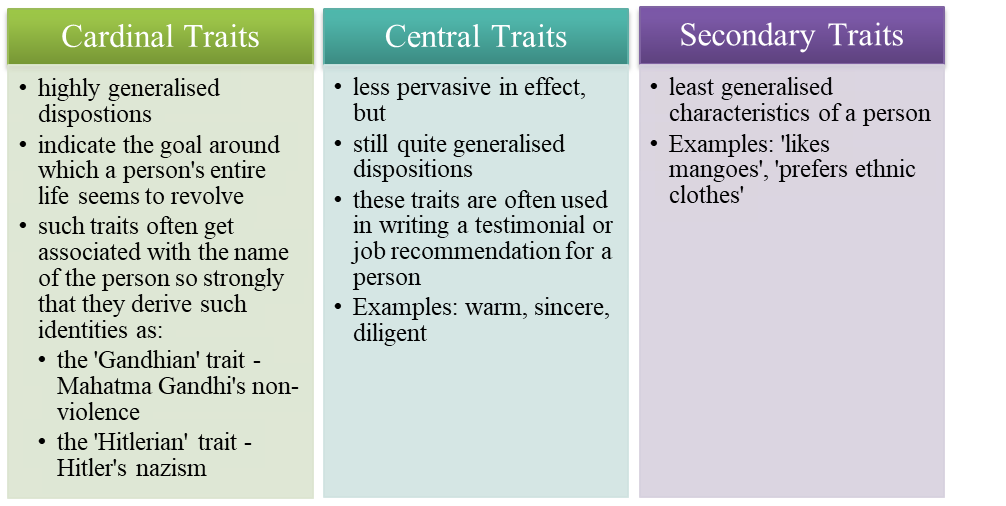
- Allport believed that the way a person reacts to given situations depends on her/his traits, although people sharing the same traits might express them in different ways.
- He considered traits more like intervening variables that occur between the stimulus situation and response of the person. This meant that any variation in traits would elicit a different response to the same situation.
3) Eysenck’s Theory
- H.J. Eysenck proposed that personality could be reduced into two broad dimensions that are biologically and genetically based.
- Each dimension subsumes a number of specific traits. These dimensions are:
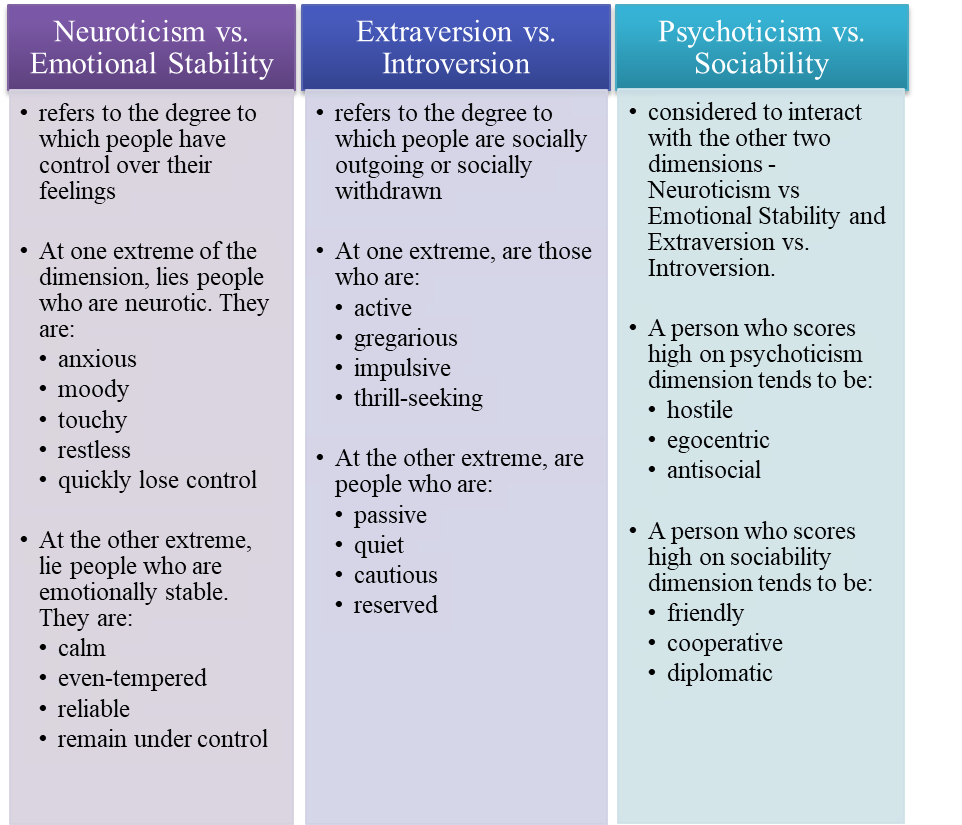
- Eysenck Personality Questionnaire is the test which is used for studying these dimensions of personality.
Interactional Approach
- It believes situational characteristics play an important role in determining our behaviour.
- People may behave as dependent or independent not because of their internal personality trait, but because of external rewards or threats available in a particular situation.
- The crosssituational consistency of traits is found to be quite low.
- The compelling influence of situations can be noted by observing people’s behaviour in places like a market, a courtroom, or a place of worship.
Five-Factor Model of Personality
- Paul Costa and Robert McCrae formulated a Big Five Factor Model of Personality indicating a set of five personality traits. They are often called Big Five Factors, also abbreviated as ‘OCEAN’. These factors include:
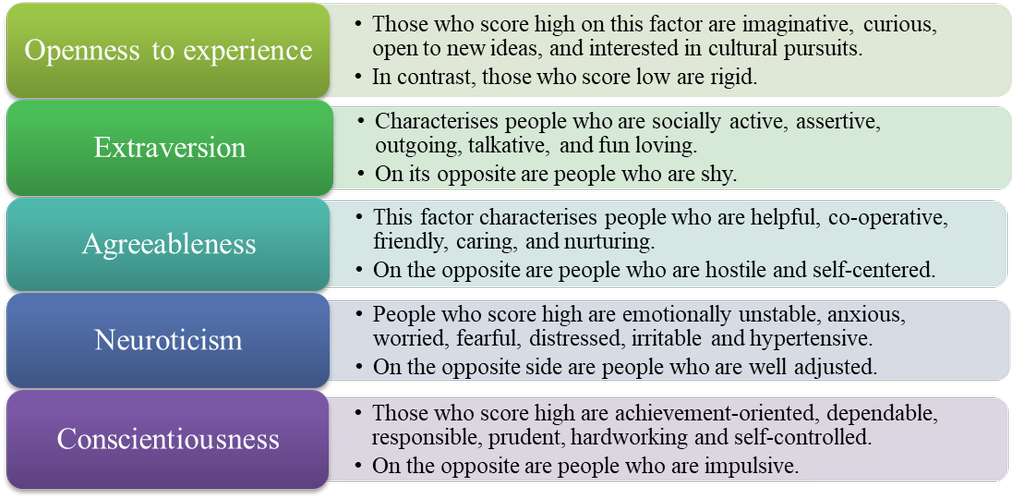
- Significance of Five-Factor Model of Personality
- an important theoretical development in the field of personality.
- useful in understanding the personality profile of people across cultures.
- considered to be the most promising empirical approach to the study of personality.
- consistent with the analysis of personality traits found in different languages.
- supported by the studies of personality carried out through different methods.
Psychodynamic Approach
- Proposed by Sigmund Freud, a physician, who developed this theory in the course of his clinical practice.
- Early in his career he used hypnosis to treat people with physical and emotional problems.
- He noted that many of his patients needed to talk about their problems, and having talked about them, they often felt better.
- Freud used:
- Free association, a method in which a person is asked to openly share all the thoughts, feelings and ideas that come to her/his mind
- Dream analysis
- Analysis of errors to understand the internal functioning of the mind
1) Levels of Consciousness
- Freud’s theory considers the sources and consequences of emotional conflicts and the way people deal with these.
- And it visualises the human mind in terms of three levels of consciousness:
Conscious
- includes the thoughts, feelings and actions of which people are aware.
Preconscious
- includes mental activity of which people may become aware only if they attend to it closely.
Unconscious
a) includes mental activity that people are unaware of.
b) reservoir of instinctive or animal drives.
c) stores all ideas and wishes that are concealed from conscious awareness, perhaps, because they lead to psychological conflicts. And most of these arise from sexual desires which cannot be expressed openly and therefore are repressed.
- People constantly struggle to find either some socially acceptable ways to express unconscious impulses, or to keep those impulses away from being expressed.
- Unsuccessful resolution of conflicts results in abnormal behaviour.
- Analysis of forgetting, mispronunciations, jokes and dreams provide us with a means to approach the unconscious.
- Freud developed a therapeutic procedure, called psychoanalysis.
- The basic goal of psychoanalytic therapy is to bring the repressed unconscious materials to consciousness, thereby helping people to live in a more self-aware and integrated manner.
2) Structure of Personality
- According to Freud’s theory, the primary structural elements of personality are three, i.e. id, ego, and superego.
- They reside in the unconscious as forces, and they can be inferred from the ways people behave.
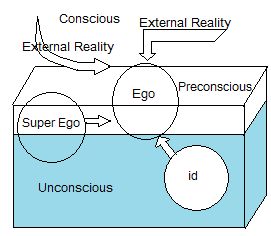
Structure of Personality in Freudian Theory
Id
a) the source of a person’s instinctual energy
b) deals with immediate gratification of primitive needs, sexual desires and aggressive impulses
c) works on the pleasure principle (based on the assumption that people seek pleasure and try to avoid pain)
d) Freud considered much of a person’s instinctual energy to be sexual, and the rest as aggressive
e) does not care for moral values, society, or other individuals
f) demanding
g) unrealistic
Ego
a) grows out of id
b) seeks to satisfy an individual’s instinctual needs in accordance with reality
c) works by the reality principle
d) directs the id towards more appropriate ways of behaving
e) patient
f) reasonable
Superego
a) moral branch of mental functioning
b) tells the id and the ego whether gratification in a particular instance is ethical
c) helps control the id by internalising the parental authority through the process of socialisation
d) does not create guilt, fear or anxiety
- The relative strength of the id, ego and superego determines each person’s stability.
- Freud also assumed that id is energised by two instinctual forces, called life instinct (also called sexual instinct) and death instinct.
- He paid less attention to the death instinct and focused more on the life (or sexual) instinct.
- The instinctual life force that energises the id is called libido. It works on the pleasure principle, and seeks immediate gratification.
Ego Defence Mechanisms
- According to Freud, much of human behaviour reflects an attempt to deal with or escape from anxiety.
- Thus, how the ego deals with anxiety largely determines how people behave.
- Freud believed that people avoid anxiety mainly by developing defence mechanisms that try to defend the ego against the awareness of the instinctual needs.
- Thus, defence mechanism is a way of reducing anxiety by distorting reality.
- People who use these mechanisms to such an extent that reality is truly distorted develop various forms of maladjustment.
- People who use defence mechanisms are often unaware of doing so.
- Each defence mechanism is a way for the ego to deal with the uncomfortable feelings produced by anxiety.
- Various kinds of defence mechanisms are:
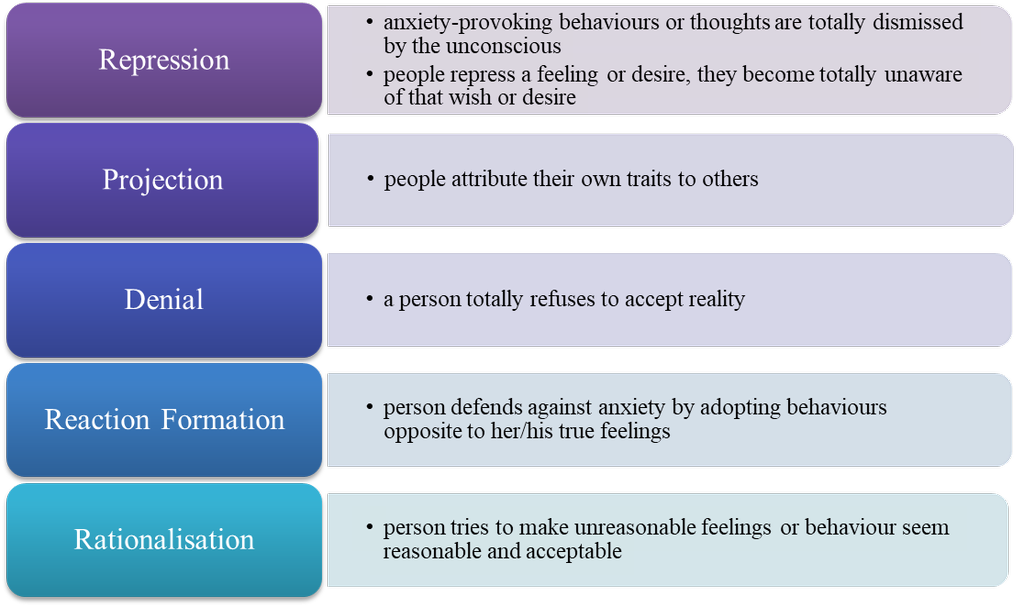
Stages of Personality Development
- Freud proposed a five-stage theory of personality (also called psychosexual) development.
- Problems encountered at any stage may arrest development, and have long-term effect on a person’s life.
- The stages of psychosexual development are:
Oral Stage
- A newborn’s instincts are focused on the mouth i.e. infant’s primary pleasure seeking centre.
- It is through the mouth that the baby obtains food that reduces hunger.
- The infant achieves oral gratification through feeding, thumb sucking, biting and babbling.
- People’s basic feelings about the world are established.
Anal Stage (around ages two and three)
- Child learns to respond to some of the demands of the society.
- One of the principal demands made by parents is that the child learns to control the bodily functions of urination and defecation.
- Children experience pleasure in moving their bowels.
- The anal area of the body becomes the focus of certain pleasurable feelings.
- Establishes the basis for conflict between the id and the ego, and between the desire for babyish pleasure and demand for adult, controlled behaviour.
Phallic Stage (around ages four and five)
- Focuses on the genitals.
- Children begin to realise the differences between males and females.
- They become aware of sexuality and the sexual relationship between their parents.
- In this stage, the male child experiences Oedipus Complex, which involves:
- love for the mother
- hostility towards the father
- consequent fear of punishment or castration by the father
A major developmental achievement of this stage is the resolution of the Oedipus complex which takes place by:
- accepting his father’s relationship with his mother
- modelling his own behaviour after his father
- give up sexual feelings for their mothers
- begin to see their fathers as role models rather than as rivals
- In this stage, the female child experiences Electra Complex, which involves:
- attaching her love to the father
- trying to symbolically marry him and raise a family
When she realises that this is unlikely, she begins to:
- identify with her mother
- copy her behaviour as a means of getting her father’s affection
Resolution of the Electra complex takes place by:
- giving up their sexual feelings or desires for their fathers
- identifying with their mother
- The critical component in resolving the Oedipus complex is the development of identification with the same sex parents.
Latency Stage (lasts from about 7 years until puberty)
- The child continues to grow physically.
- Sexual urges are relatively inactive.
- Much of a child’s energy is channelled into social or achievement-related activities.
Genital Stage
- The person attains maturity in psychosexual development.
- The sexuality, fears and repressed feelings of earlier stages are once again exhibited.
- People learn to deal with members of the opposite sex in a socially and sexually mature way.
- However, if the journey towards this stage is marked by excessive stress or over-indulgence, it may cause fixation to an earlier stage of development.
Fixation
- Failure of a child to pass successfully through a stage leads to fixation to that stage.
Regression
- It takes a person back to an earlier stage.
- It occurs when a person’s resolution of problems at any stage of development is less than adequate.
- In this situation, people display behaviours typical of a less mature stage of development.
Criticisms of Psychodynamic theories:
- The theories are largely based on case studies; they lack a rigorous scientific basis.
- They use small and atypical individuals as samples for advancing generalisations.
- The concepts are not properly defined, and it is difficult to submit them to scientific testing.
- Freud has used males as the prototype of all human personality development. He overlooked female experiences and perspectives.
Post-Freudian Approaches/ Neo Analytic
- Characterised by less prominent roles to sexual and aggressive tendencies of the id
- Expansion of the concept of ego
- Emphasis on the human qualities of creativity, competence, and problem solving abilities
Carl Jung: Aims and Aspirations
- Humans are guided as much by aims and aspirations as by sex and aggression.
- Developed his own theory of personality, called analytical psychology.
The basic assumption of his theory is that personality consists of competing forces and structures within the individual (that must be balanced) rather than between the individual and the demands of society, or between the individual and reality.
- Jung claimed that there was a collective unconscious consisting of archetypes or primordial images, which are not individually acquired, but are inherited. Example - The God or the Mother Earth. They are found in myths, dreams and arts of all mankind.
- Jung held that the self strives for unity and oneness. According to him, for achieving unity and wholeness, a person must become increasingly aware of the wisdom available in one’s personal and collective unconscious, and must learn to live in harmony with it.
Karen Horney: Optimism
- Adopted a more optimistic view of human life with emphasis on human growth and self-actualisation.
- Major contribution lies in her challenge to Freud’s treatment of women as inferior.
- According to her, each sex has attributes to be admired by the other, and neither sex can be viewed as superior or inferior.
- She countered that women were more likely to be affected by social and cultural factors than by biological factors.
- She argued that psychological disorders were caused by disturbed interpersonal relationship during childhood.
- When parents’ behaviour toward a child is indifferent, discouraging, and erratic, the child feels insecure and a feeling called basic anxiety results.
- Deep resentment toward parents or basic hostility occurs due to this anxiety.
- By showing excessive dominance or indifference, or by providing too much or too little approval, parents can generate among children feelings of isolation and helplessness which interfere with their healthy development.
Alfred Adler: Lifestyle and Social Interest
- Adler’s theory is known as individual psychology.
- His basic assumption is that human behaviour is purposeful and goal-directed.
- Each one of us has the capacity to choose and create.
- Our personal goals are the sources of our motivation.
- The goals that provide us with security and help us in overcoming the feelings of inadequacy are important in our personality development.
- In Adler’s view, every individual suffers from the feelings of inadequacy and guilt, i.e. inferiority complex, which arise from childhood.
- Overcoming this complex is essential for optimal personality development.
Erich Fromm: The Human Concerns
- Developed his theory from a social orientation.
- Viewed human beings as basically social beings who could be understood in terms of their relationship with others.
- Psychological qualities such as growth and realisation of potentials resulted from a desire for freedom, and striving for justice and truth.
- Character traits (personality) develop from our experiences with other individuals.
- While culture is shaped by the mode of existence of a given society, people’s dominant character traits in a given society work as forces in shaping the social processes and the culture itself.
- His work recognises the value of positive qualities, such as tenderness and love in personality development.
Erik Erikson: Search for Identity
- Emphasises on rational, conscious ego processes in personality development.
- Development is viewed as a lifelong process, and ego identity is granted a central place in this process.
- His concept of identity crisis of adolescent age has drawn considerable attention.
- Erikson argues that young people must generate for themselves a central perspective and a direction that can give them a meaningful sense of unity and purpose.
Behavioural Approach
- This approach does not give importance to the internal dynamics of behaviour.
- The behaviourists believe in data, which they feel are definable, observable, and measurable.
- They focus on learning of stimulus-response connections and their reinforcement.
- According to them, personality can be best understood as the response of an individual to the environment.
- They see the development simply as a change in response characteristics, i.e. a person learns new behaviours in response to new environments and stimuli.
- The structural unit of personality is the response.
- Each response is a behaviour, which is emitted to satisfy a specific need.
- The core tendency that organises behaviour is the reduction of biological or social needs that energise behaviour.
This is accomplished through responses (behaviours) that are reinforced.
- The principles of theories of learning (classical conditioning, instrumental conditioning, and observational learning) have been widely used in developing personality theories.
For example:
- Observational learning theory considers thought processes extremely important in learning, but these find almost no place in classical or instrumental conditioning theories.
- Observational learning theory also emphasises social learning (based on observation and imitation of others) and self-regulation, which again is missed out in other theories.
Cultural Approach
- Attempts to understand personality in relation to the features of ecological and cultural environment.
- Proposes that a group’s ‘economic maintenance system’ plays a vital role in the origin of cultural and behavioural variations.
- People’s skills, abilities, behavioural styles, and value priorities are viewed as strongly linked to the features such as settlement patterns, social structures, division of labour, child rearing practices, etc.
- Rituals, ceremonies, religious practices, arts, recreational activities, games and play are the means through which people’s personality gets projected in a culture.
- People develop various personality (behavioural) qualities in an attempt to adapt to the ecological and cultural features of a group’s life.
- The cultural approach considers personality as an adaptation of individuals or groups to the demands of their ecology and culture.
Humanistic Approach (in response to Freud’s theory)
Carl Rogers’ Contribution to the Development of Humanistic Perspective on Personality:
- The most important idea proposed by Rogers is that of a fully functioning person.
He believes that fulfilment is the motivating force for personality development.
People try to express their capabilities, potentials and talents to the fullest extent possible.
There is an inborn tendency among persons that directs them to actualise their inherited nature.
- Rogers makes two basic assumptions about human behaviour.
- Behaviour is goal-directed and worthwhile.
- People (who are innately good) will almost always choose adaptive, self-actualising behaviour.
- His theory is structured around the concept of self.
The theory assumes that people are constantly engaged in the process of actualising their true self.
Rogers suggests that each person also has a concept of ideal self i.e. the self that a person would like to be.
When there is a correspondence between the real self and ideal self, a person is generally happy. Discrepancy between the real self and ideal self often results in unhappiness and dissatisfaction. Rogers’ basic principle is that people have a tendency to maximise self-concept through self-actualisation.
In this process, the self grows, expands and becomes more social.
- Rogers views personality development as a continuous process which involves learning to evaluate oneself and mastering the process of self-actualisation.
He recognises the role of social influences in the development of self-concept.
When social conditions are positive, the self-concept and self-esteem are high.
In contrast, when the conditions are negative, the self-concept and self-esteem are low.
People with high self-concept and self-esteem are generally flexible and open to new experiences, so that they can continue to grow and self-actualise.
- This situation warrants that an atmosphere of unconditional positive regard must be created in order to ensure enhancement of people’s self-concept.
The client-centred therapy that Rogers developed basically attempts to create this condition.
Abraham Maslow’s Contribution to the Development of Humanistic Perspective on Personality:
- Maslow has given a detailed account of psychologically healthy people in terms of their attainment of self-actualisation, a state in which people have reached their own fullest potential.
- He had an optimistic and positive view of man who has the potentialities for love, joy and to do creative work.
- Human beings are considered free to shape their lives and to self-actualise.
- Self-actualisation becomes possible by analysing the motivations that govern our life.
- An individual’s sole concern with the satisfaction of survival needs (biological, security, and belongingness needs) reduces her/ him to the level of animals.
- The real journey of human life begins with the pursuit of self-esteem and selfactualisation needs.
- The humanistic approach emphasises the significance of positive aspects of life.

Characteristics of a healthy person according to humanistic theorists:
- They become aware of themselves, their feelings, and their limits; accept themselves, and what they make of their lives as their own responsibility; have ‘the courage to be’.
- They experience the “here-and-now”; are not trapped.
- They do not live in the past or dwell in the future through anxious expectations and distorted defences.
Assessment of Personality
- Books Name
- Psychology Book Class-12
- Publication
- PathSet Publications
- Course
- CBSE Class 12
- Subject
- Psychology
Assessment of Personality
- It is a formal effort aimed at understanding personality of an individual.
- Assessment refers to the procedures used to evaluate or differentiate people on the basis of certain characteristics.
- The goal of assessment is to understand and predict behaviour with minimum error and maximum accuracy.
- Assessment is used to study what a person generally does, or how s/he behaves, in a given situation.
- Assessment is also useful for diagnosis, training, placement, counselling, and other purposes.
Self-report Measures (direct method)
- Suggested by Allport
- A method to assess a person by asking her/him about herself/himself.
- Fairly structured measures, often based on theory, that require subjects to give verbal responses using some kind of rating scale.
- Requires the subject to objectively report her/his own feelings with respect to various items.
- The responses are accepted at their face value.
- They are scored in quantitative terms and interpreted on the basis of norms developed for the test.
The Minnesota Multiphasic Personality Inventory (MMPI)
- Widely used as a test in personality assessment.
- Developed by Hathaway and McKinley as helping tool for psychiatric diagnosis.
- Very effective in identifying varieties of psychopathology.
- Its revised version is available as MMPI-2.
- Consists of 567 statements to be judged as ‘true’ or ‘false’ by the subject for her/ him.
- The test is divided into 10 subscales, which seek to diagnose:
- Hypochondriasis
- Depression
- Hysteria
- Psychopathic deviate
- Masculinity-femininity
- Paranoia
- Psychasthenia
- Schizophrenia
- Mania
- Social introversion
- In India, Mallick and Joshi have developed the Jodhpur Multiphasic Personality Inventory (JMPI) along the lines of MMPI.
Eysenck Personality Questionnaire (EPQ)
- Developed by Eysenck.
- This test is also widely used.
- This test initially assessed two dimensions of personality, called introverted-extraverted and emotionally stable-emotionally unstable.
- These dimensions are characterised by 32 personality traits.
- Later on, Eysenck added a third dimension, called psychoticism i.e. linked to psychopathology that represents:
- a lack of feeling for others
- a tough manner of interacting with people
- a tendency to defy social conventions.
A person scoring high on this dimension tends to be hostile, egocentric, and antisocial.
Sixteen Personality Factor Questionnaire (16 PF)
- Developed by Cattell.
- He identified a large set of personality descriptors, which were subjected to factor analysis to identify the basic personality structure.
- Provides with declarative statements, and the subject responds to a specific situation by choosing from a set of given alternatives.
- Can be used with high school level students as well as with adults.
- Extremely useful in career guidance, vocational exploration, and occupational testing.
Limitations of Self-Report Measures
- Social Desirability is a tendency on the part of the respondent to endorse items in a socially desirable manner.
- Acquiescence is a tendency of the subject to agree with items/questions irrespective of their contents. It often appears in the form of saying ‘yes’ to items.
These tendencies render the assessment of personality less reliable.
Projective Techniques (indirect method)
- Developed to assess unconscious motives and feelings.
- Based on the assumption that a less structured or unstructured stimulus or situation will allow the individual to project her/his feelings, desires and needs on to that situation.
- These projections are interpreted by experts.
- Various kinds of stimulus materials and situations for assessing personality are used. Some of them require reporting associations with stimuli (e.g., words, inkblots), some involve story writing around pictures, some require sentence completions, some require expression through drawings, and some require choice of stimuli from a large set of stimuli.
- The nature of stimuli and responses in these techniques share the following features:
- The stimuli are relatively or fully unstructured and poorly defined.
- The person being assessed is usually not told about the purpose of assessment and the method of scoring and interpretation.
- The person is informed that there are no correct or incorrect responses.
- Each response is considered to reveal a significant aspect of personality.
- Scoring and interpretation are lengthy and sometimes subjective.
- Projective techniques cannot be scored in any objective manner.
- They generally require qualitative analyses for which a rigorous training is needed.
The Rorschach Inkblot Test
- Developed by Hermann Rorschach.
- Consists of 10 inkblots:
- 5 of them are in black and white
- 2 with some red ink
- 3 in some pastel colours
- The blots are symmetrical in design with a specific shape or form.
- Each blot is printed in the centre of a white cardboard of about 7”´10” size.
- The blots were originally made by dropping ink on a piece of paper and then folding the paper in half (hence called inkblot test).
- The cards are administered individually in two phases:
- In the first phase, called performance proper, the subjects are shown the cards and are asked to tell what they see in each of them.
- In the second phase, called inquiry, a detailed report of the response is prepared by asking the subject to tell where, how, and on what basis was a particular response made.
- Fine judgment is necessary to place the subject’s responses in a meaningful context.
- The use and interpretation of this test requires extensive training.
- Computer techniques too have been developed for analysis of data.
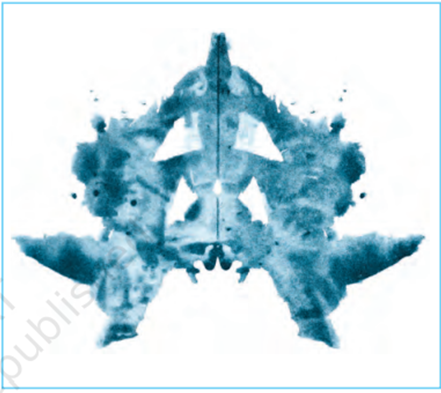
The Thematic Apperception Test (TAT)
- Developed by Morgan and Murray.
- A little more structured than the Inkblot test.
- Consists of 30 black and white picture cards and one blank card.
- Each picture card depicts one or more people in a variety of situations.
- Each picture is printed on a card.
- Some cards are used with adult males or females. Others are used with boys or girls. Still others are used in some combinations.
- 20 cards are appropriate for a subject, although a lesser number of cards (even five) have also been successfully used.
- The cards are presented one at a time.
- The subject is asked to tell a story describing the situation presented in the picture:
- What led up to the situation?
- What is happening at the moment?
- What will happen in the future?
- What the characters are feeling and thinking?
- A standard procedure is available for scoring TAT responses.
- The test has been modified for children and for the aged.
- Uma Chaudhury’s Indian adaptation of TAT is also available.
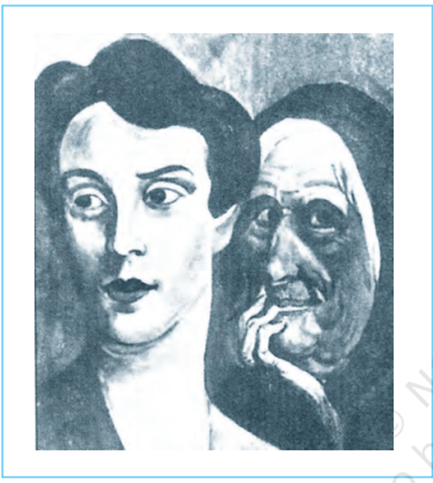
Rosenzweig’s Picture-Frustration Study (P-F Study)
- Developed by Rosenzweig
- To assess how people express aggression in the face of a frustrating situation.
- The test presents with the help of cartoon like pictures a series of situations in which one person frustrates another, or calls attention to a frustrating condition.
- The subject is asked to tell what the other (frustrated) person will say or do.
- The analysis of responses is based on the type and direction of aggression.
- An attempt is made to examine whether the focus is on the frustrating object, or on protection of the frustrated person, or on constructive solution of the problem.
- The direction of aggression may be towards the environment, towards oneself, or it may be tuned off in an attempt to gloss over or evade the situation.
- Pareek has adapted this test for use with the Indian population.
Sentence Completion Test
- This test makes use of a number of incomplete sentences.
- The starting part of the sentence is first presented and the subject has to provide an ending to the sentence.
- The type of endings used by the subjects reflect their attitudes, motivation and conflicts.
- The test provides subjects with several opportunities to reveal their underlying unconscious motivations.
- A few sample items of a sentence completion test are given below:
- My father_________________.
- My greatest fear is_________________.
- The best thing about my mother is _______________.
- I am proud of ___________________.
Draw-a-Person Test
- It is a simple test in which the subject is asked to draw a person on a sheet of paper. A pencil and eraser is provided to facilitate drawing.
- After the completion of the drawing, the subject is generally asked to draw the figure of an opposite sex person.
- Finally, the subject is asked to make a story about the person as if s/he was a character in a novel or play.
- Some examples of interpretations are as follows:
- Omission of facial features suggests that the person tries to evade a highly conflict-ridden interpersonal relationship.
- Graphic emphasis on the neck suggests lack of control over impulses.
- Disproportionately large head suggests organic brain disease and pre-occupation with headaches.
Advantages of Projective Techniques
- Helps to understand unconscious motives, deep-rooted conflicts, and emotional complexes of an individual.
- The analysis of personality with the help of projective techniques appears fairly interesting.
Limitations of Projective Techniques
- The interpretation of the responses requires sophisticated skills and specialised training.
- There are problems associated with the reliability of scoring and validity of interpretations.
Behavioural Analysis
- A person’s behaviour in a variety of situations can provide us with meaningful information about her/his personality.
- Observation of behaviour serves as the basis of behavioural analysis.
Interview
- Commonly used method for assessing personality.
- Involves talking to the person being assessed and asking specific questions.
- Diagnostic interviewing generally involves in-depth interviewing which seeks to go beyond the replies given by the person.
- Interviews may be structured or unstructured depending on the purpose or goals of assessment:
- In unstructured interviews, the interviewer seeks to develop an impression about a person by asking a number of questions. The way a person presents her/ himself and answers the questions carries enough potential to reveal her/his personality.
- The structured interviews address very specific questions and follow a set procedure. This is often done to make objective comparison of persons being interviewed.
Observation
- Commonly used for the assessment of personality.
- Sophisticated procedure that cannot be carried out by untrained people.
- Requires careful training of the observer.
- Requires a fairly detailed guideline about analysis of behaviours in order to assess the personality of a given person.
Limitations of Observation and Interview methods:
- Professional training required for collection of useful data through these methods is quite demanding and timeconsuming.
- Maturity of the psychologist is a precondition for obtaining valid data through these techniques.
- Mere presence of the observer may contaminate the results. As a stranger, the observer may influence the behaviour of the person being observed and thus not obtain good data.
Behavioural Ratings
- Used for assessment of personality in educational and industrial settings.
- Taken from people who know the assessee intimately and have interacted with her/him over a period of time or have had a chance to observe her/him.
- Attempts to put individuals into certain categories in terms of their behavioural qualities.
- The categories may involve different numbers or descriptive terms.
- Use of numbers or general descriptive adjectives in rating scales always creates confusion for the rater.
- In order to use ratings effectively, the traits should be clearly defined in terms of carefully stated behavioural anchors.
Limitations of Behavioural Ratings:
Halo Effect
- Raters often display certain biases that colour their judgments of different traits. For eg, most of us are greatly influenced by a single favourable or unfavourable trait. This often forms the basis of a rater’s overall judgment of a person.
- Raters have a tendency to place individuals either in the middle of the scale (called middle category bias) by avoiding extreme positions, or in the extreme positions (called extreme response bias) by avoiding middle categories on the scale.
Nomination
- Used in obtaining peer assessment.
- Can be used with persons who have been in long-term interaction and who know each other very well.
- In nomination, each person is asked to choose one or more persons of the group with whom s/he would like to work, study, play/participate in any other activity.
- The person may also be asked to specify the reason for her/his choices.
- Analysed to understand the personality and behavioural qualities of the person.
- Found to be highly dependable, although it may also be affected by personal biases.
Situational Tests
- Commonly used test of this kind is the situational stress test.
- Provides us with information about how a person behaves under stressful situations.
- The test requires a person to perform a given task with other persons who are instructed to be non-cooperative and interfering.
- The test involves a kind of role playing.
- The person is instructed to play a role for which s/he is observed.
- A verbal report is also obtained on what s/he was asked to do.
- The situation may be realistic one, or it may be created through a video play.

 PathSet Publications
PathSet Publications
